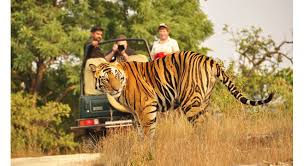A qualitative research study accomplished by HTF MI titled “Case Study: Wildlife Tourism Market covers detailed Product / Industry Scope, current and future market size scenario and elaborates outlook and status to 2025” provides primary data, studies and vendor briefings. The market Study is segmented by key regions along with country level break-up which is accelerating the marketization and by products type, application/end-users. The research study provides estimates for Case Study: Wildlife Tourism forecast till 2025. Some of the Major Players Included in the study are Amadeus, Bushtops, UNESCO, Tree Tops Elephant Reserve Co. Ltd, Instagram etc.
Get Free Sample Report + All Related Graphs & Charts @:https://www.htfmarketreport.com/sample-report/2463616-case-study-wildlife-tourism
Summary
Wildlife tourism allows tourists to experience animals in their natural habitat. It includes eco and animal friendly tourism, but there is also a dark side, which raises ethical concerns.
There are various forms of wildlife tourism that tourists can experience including safaris, coral reef diving, animal watching and more.
This niche tourism type boosts the local economy of a destination. According to WTTC, in 2018, wildlife tourism contributed 4.4% to tourism GDP and provided 9.1 million jobs worldwide. This case study looks at this popular niche tourism type.
To know more about the table of contents, you can click @ https://www.htfmarketreport.com/reports/2463616-case-study-wildlife-tourism
Key Highlights
– This niche tourism type boosts the local economy of a destination. According to WTTC, in 2018, wildlife tourism contributed 4.4% to tourism GDP and provided 9.1 million jobs worldwide.
– Wildlife tourism allows tourists to interact and observe animals that they usually wouldn’t see in their local country in the wild. For example, when on a safari in Africa tourists have the potential to see wildlife such as lions, tigers, rhinos and many more that tourists will not observe in the wild in their own country.
– There are benefits to wildlife tourism including economic benefits of providing money for conservation and reserves to protect the wildlife.
– However, there is also a dark side to wildlife tourism, which raises ethical concerns.
Scope
– Wildlife tourism allows tourists to experience animals in their natural habitat. It includes eco and animal friendly tourism, but there is also a dark side, which raises ethical concerns.
– There are various forms of wildlife tourism that tourists can experience including safaris, coral reef diving, animal watching and more.
– This niche tourism type boosts the local economy of a destination. According to WTTC, in 2018, wildlife tourism contributed 4.4% to tourism GDP and provided 9.1 million jobs worldwide. This case study looks at this popular niche tourism type.
Buy this research report @ https://www.htfmarketreport.com/buy-now?format=1&report=2463616
Reasons to buy
– Gain an insight into the wildlife tourism industry
– Understand the appeal and potential pitfalls that this popular form of niche tourism presents
– Analyze examples of leading wildlife tourism destinations
Companies Mentioned in the Report
Amadeus
Bushtops
UNESCO
Tree Tops Elephant Reserve Co. Ltd
Thanks for reading this article; you can also get individual chapter wise section or region wise report version like North America, Europe or Asia.
Media Contact
Company Name: HTF Market Intelligence Consulting Private Limited
Contact Person: Craig Francis
Email: Send Email
Phone: 2063171218
Address:Unit No. 429, Parsonage Road
City: Edison
State: New Jersey
Country: United States
Website: https://www.htfmarketreport.com/reports/2463616-case-study-wildlife-tourism

